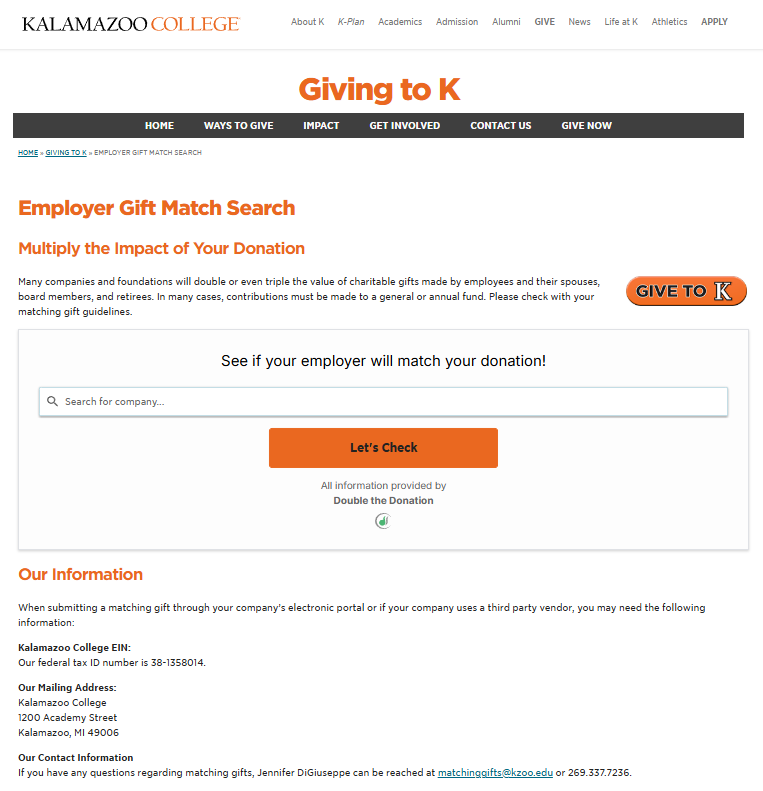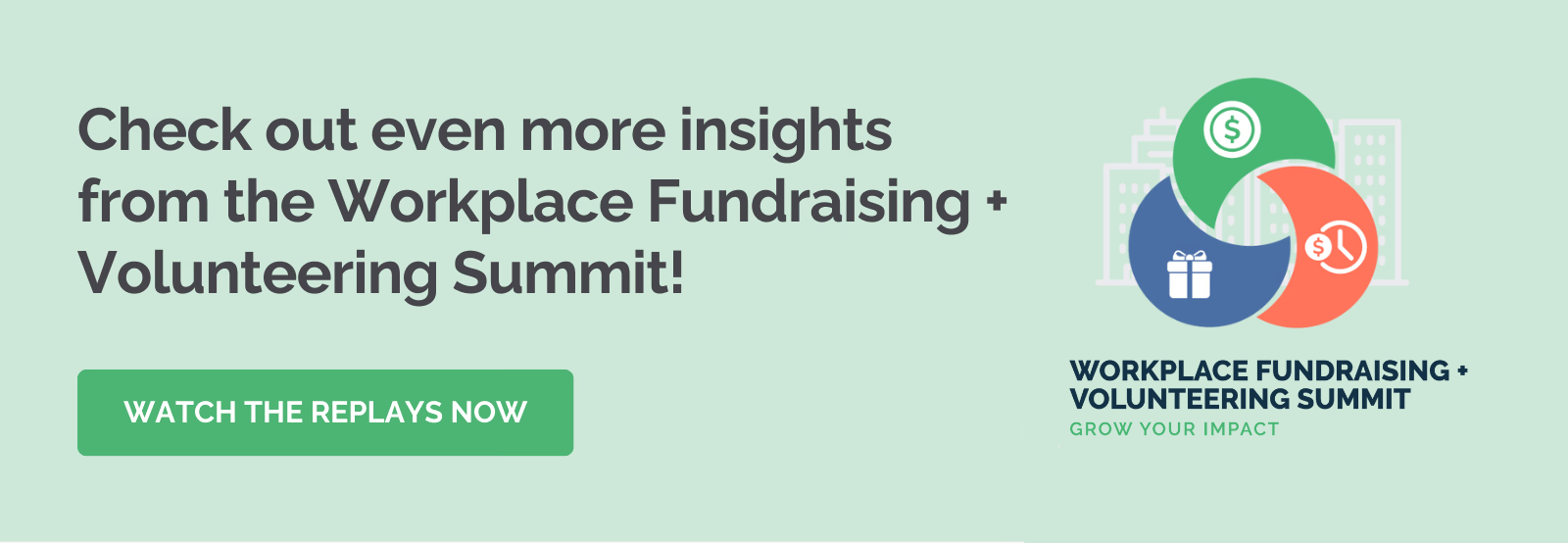6 Workplace Giving Insights From the Fall 2025 Summit Event
According to the latest Giving USA report, corporate giving has reached an all-time high, signaling a tremendous opportunity for nonprofits to tap into workplace giving programs. Yet, workplace giving remains an underutilized avenue for many nonprofits. By strategically engaging with these programs, nonprofits can unlock new levels of growth and support, ensuring they continue to innovate and thrive in an increasingly competitive fundraising landscape.
At the recent Workplace Fundraising + Volunteering Summit, industry experts shared actionable strategies for nonprofits to make the most of these programs. Here, we explore six key insights that can help nonprofits raise more through workplace giving. These include:
- Collaborating Across Departments
- Utilizing Existing Platforms and Tools
- Enlisting Multi-Channel Engagement for Workplace Giving
- Leveraging Employer Data to Enhance Outreach
- Establishing Consistent Acknowledgments
- Testing and Scaling Your Efforts
As nonprofits face increasing competition for corporate donor attention and support, workplace giving programs offer a unique and scalable opportunity for growth. These strategies not only help nonprofits maximize revenue but also provide a structured approach to developing sustainable and mutually beneficial partnerships.
Let’s begin.
1) Collaborating Across Departments:
One of the most significant insights from the summit was the importance of collaboration across departments within nonprofits. As Erica Tolentino, Senior Director of National Operations at the Crohn’s and Colitis Foundation, explained, “Successful workplace giving programs require cross-department collaboration.” At her organization, the matching gift team works closely with events, fundraising, volunteering, and marketing departments to integrate matching gift information into various campaigns.
Erica also emphasized the importance of creating resources that simplify the matching gift process for both staff and donors. “We developed email templates for common matching gift questions, FAQs, and a Workplace Giving Toolkit,” she shared. These resources not only reduce confusion but also make it easier for volunteers and staff to engage in matching gift activities, driving increased donor participation. This collaboration creates a unified approach that maximizes efficiency and enhances the donor experience.
Learn even more about building a workplace fundraising team with the on-demand presentation available here.
2) Utilizing Existing Platforms and Tools
Another valuable takeaway was the importance of fully utilizing existing workplace giving platforms. Gillian Wagner, Senior Fundraising Manager at Global Impact, encouraged nonprofits to optimize the tools available through workplace giving solutions like Benevity, Your Cause, and Double the Donation. Together, these platforms provide nonprofits with powerful tools to track donations, engage with corporate partners, and automate thank-you messages.
At Kalamazoo College, for example, they use Double the Donation’s workplace giving widget on their website to encourage donors to check if their companies offer matching gifts. From there, by ensuring their free profiles are fully updated on CSR platforms like Benevity and Your Cause, the school has streamlined the process of identifying matching gift opportunities, making it easier to track and engage with workplace donors.
Gillian also emphasized the value of automation in workplace giving, noting that while these programs require sustained effort, automation helps ease the workload. In other words, automated thank-yous and communication systems can ensure that workplace donors are regularly acknowledged without overwhelming the fundraising team.
Looking for instructions on registering with leading CSR platforms? Check out this handy guide.
3) Enlisting Multi-Channel Engagement for Workplace Giving:
Engaging workplace donors effectively requires reaching them through multiple channels, ensuring that your message resonates with them no matter how they prefer to receive information. Kalamazoo College has mastered this strategy by incorporating a combination of communication methods, each designed to reach a broad spectrum of workplace donors.
One key element of the college’s multi-channel approach is its website. Kalamazoo College uses its main site not only to provide detailed information about workplace giving opportunities but also to include tools that make the giving process as seamless as possible. By integrating a matching gift lookup tool into their donation page, the college allows donors to easily check if their employers participate, making it effortless for them to initiate or increase their donations.
Kalamazoo College also utilizes direct mail to reach workplace donors. To enhance the impact of direct mail, the college has included QR codes in its mailers, allowing recipients to quickly scan the code and access online resources, including details about matching gifts and donation forms. This small yet powerful addition makes it easier for donors to take action immediately, thereby increasing conversion rates.
Email campaigns also play a pivotal role in Kalamazoo’s workplace giving strategy. Email provides a direct, personalized method of communication. Regularly scheduled email communications keep supporters informed about upcoming giving opportunities while also promoting the value of matching gifts. Kalamazoo College leverages automation within these email campaigns to send timely reminders.
Social media is another key component of Kalamazoo’s multi-channel engagement strategy. The college taps into the power of platforms like LinkedIn, Facebook, and Instagram to spread awareness about workplace giving. Engaging content, such as testimonials from alumni and employees who have benefitted from workplace giving, helps to humanize the process and shows potential donors the tangible impact of their contributions.
4) Leveraging Employer Data to Enhance Outreach:
One of the most effective ways to boost workplace giving is by leveraging employer data to identify potential matching gift opportunities. Kalamazoo College used Double the Donation to cross-reference their donor database with workplace giving data, allowing them to identify spouses or partners of alumni who could access matching gift programs. This strategic use of data helped the college enhance its outreach and tailor its messaging to specific companies, making its appeals more targeted and effective.
By identifying companies where they had a high concentration of alumni, Kalamazoo College was able to engage directly with these employees and encourage them to take part in the college’s Giving Tuesday campaign. This data-driven approach helped the college maximize matching gift opportunities and raise more funds.
Looking to learn more about employer data for workplace giving? Watch the presentation replay here.
5) Establishing Consistent Acknowledgments:
One of the challenges that many nonprofits face is ensuring that workplace donors are properly acknowledged. As Gillian Wagner pointed out, “Most workplace giving platforms send a tax receipt without any personal messaging or branding from the nonprofit.” This lack of acknowledgment can lead to donor disengagement. Instead, nonprofits need to establish a clear, consistent process for thanking workplace donors and ensuring they feel appreciated for their contributions.
Gillian stressed the importance of creating a personalized acknowledgment system, saying, “Workplace giving isn’t about immediate conversions or instant donations. It’s about building long-term relationships.” Acknowledging donors promptly and personally helps build trust and encourages ongoing participation.
For more tips on workplace donor cultivation, check out the full Summit presentation here.
6) Testing and Scaling Your Efforts:
For nonprofits new to workplace giving or looking to optimize their efforts, Gillian Wagner advised starting small and testing strategies. “Start with a small group of corporate partners or high-value donors, test your strategies, refine your processes, and then scale up as you gain more confidence,” she said. For the best results, nonprofits should focus on experimenting with different engagement methods and communication strategies to identify what resonates best with workplace donors.
Kalamazoo College used this approach by focusing on a small group of donors who were most likely to engage with matching gift opportunities. Once they gained more experience, the school’s development team expanded its efforts and continuously optimized its strategies. This step-by-step approach allows nonprofits to test the waters without overwhelming their resources and ensures that they can scale up their efforts once they’re confident in their process.
Wrapping Up
Workplace giving presents a unique opportunity for nonprofits to tap into a steady stream of revenue, build lasting relationships with donors, and enhance their overall fundraising efforts. By collaborating across departments, utilizing existing platforms, engaging donors through multiple channels, and leveraging employer data, nonprofits can maximize their workplace giving programs.
It’s important to remember that workplace giving is a long-term strategy. Nonprofits must focus on building strong relationships with workplace donors through consistent acknowledgment, personalized communication, and targeted outreach. And while testing and scaling efforts may take time, the results can be well worth the investment.




